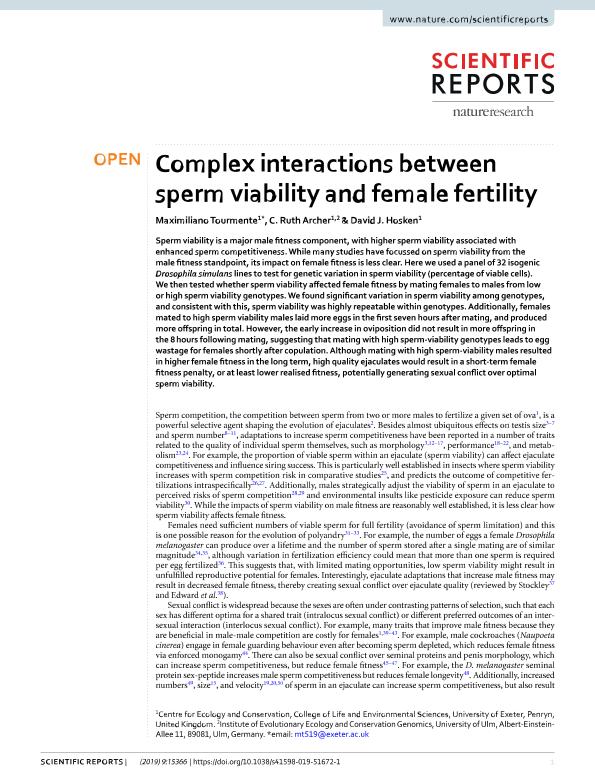Mostrar el registro sencillo del ítem
dc.contributor.author
Tourmente, Maximiliano

dc.contributor.author
Archer, C. Ruth
dc.contributor.author
Hosken, David J.
dc.date.available
2020-03-25T15:24:14Z
dc.date.issued
2019-12
dc.identifier.citation
Tourmente, Maximiliano; Archer, C. Ruth; Hosken, David J.; Complex interactions between sperm viability and female fertility; Nature Publishing Group; Scientific Reports; 9; 1; 12-2019; 15366-15366
dc.identifier.issn
2045-2322
dc.identifier.uri
http://hdl.handle.net/11336/100690
dc.description.abstract
Sperm viability is a major male fitness component, with higher sperm viability associated with enhanced sperm competitiveness. While many studies have focussed on sperm viability from the male fitness standpoint, its impact on female fitness is less clear. Here we used a panel of 32 isogenic Drosophila simulans lines to test for genetic variation in sperm viability (percentage of viable cells). We then tested whether sperm viability affected female fitness by mating females to males from low or high sperm viability genotypes. We found significant variation in sperm viability among genotypes, and consistent with this, sperm viability was highly repeatable within genotypes. Additionally, females mated to high sperm viability males laid more eggs in the first seven hours after mating, and produced more offspring in total. However, the early increase in oviposition did not result in more offspring in the 8 hours following mating, suggesting that mating with high sperm-viability genotypes leads to egg wastage for females shortly after copulation. Although mating with high sperm-viability males resulted in higher female fitness in the long term, high quality ejaculates would result in a short-term female fitness penalty, or at least lower realised fitness, potentially generating sexual conflict over optimal sperm viability.
dc.format
application/pdf
dc.language.iso
eng
dc.publisher
Nature Publishing Group

dc.rights
info:eu-repo/semantics/openAccess
dc.rights.uri
https://creativecommons.org/licenses/by/2.5/ar/
dc.subject
SPERM VIABILITY
dc.subject
SEXUAL CONFLICT
dc.subject
FEMALE FERTILITY
dc.subject
SPERM COMPETITION
dc.subject
DROSOPHILA
dc.subject.classification
Biología Celular, Microbiología

dc.subject.classification
Ciencias Biológicas

dc.subject.classification
CIENCIAS NATURALES Y EXACTAS

dc.subject.classification
Biología

dc.subject.classification
Ciencias Biológicas

dc.subject.classification
CIENCIAS NATURALES Y EXACTAS

dc.title
Complex interactions between sperm viability and female fertility
dc.type
info:eu-repo/semantics/article
dc.type
info:ar-repo/semantics/artículo
dc.type
info:eu-repo/semantics/publishedVersion
dc.date.updated
2020-01-13T14:35:12Z
dc.journal.volume
9
dc.journal.number
1
dc.journal.pagination
15366-15366
dc.journal.pais
Estados Unidos

dc.description.fil
Fil: Tourmente, Maximiliano. Consejo Nacional de Investigaciones Científicas y Técnicas. Centro Científico Tecnológico Conicet - Córdoba. Instituto de Investigaciones Biológicas y Tecnológicas. Universidad Nacional de Córdoba. Facultad de Ciencias Exactas, Físicas y Naturales. Instituto de Investigaciones Biológicas y Tecnológicas; Argentina. University of Exeter; Reino Unido
dc.description.fil
Fil: Archer, C. Ruth. University of Exeter; Reino Unido. Universitat Ulm; Alemania
dc.description.fil
Fil: Hosken, David J.. University of Exeter; Reino Unido
dc.journal.title
Scientific Reports
dc.relation.alternativeid
info:eu-repo/semantics/altIdentifier/url/https://www.nature.com/articles/s41598-019-51672-1
dc.relation.alternativeid
info:eu-repo/semantics/altIdentifier/doi/http://dx.doi.org/10.1038/s41598-019-51672-1
Archivos asociados
